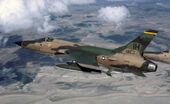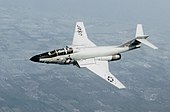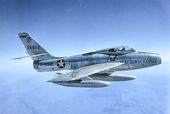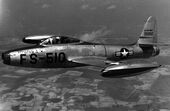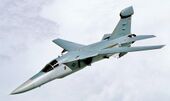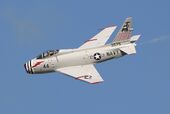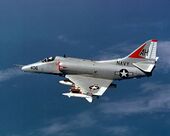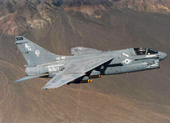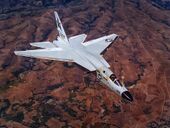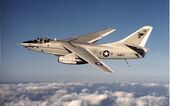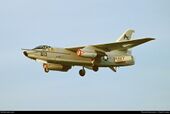Retired Aircraft of the Arcadian Federal Armed Forces
Jump to navigation
Jump to search
Aircraft
Arcadian Federal Air Forces
| Aircraft | Photo | Origin | Role | Version | Time in Service | Comment |
|---|---|---|---|---|---|---|
| Fighter/Interceptor aircraft | ||||||
| I-1 Angel | Interceptor | I-1 I-1M |
1952-1968 | The Angel was the first of the jet-powered, high-powered interceptors designed to counter foreign strategic bomber designs. While the Hawk was reliable and effective, it was quickly superseded by its significantly improved successor, the I-3 Archangel. | ||
| I-2 Rocketeer | Interceptor | I-2 I-2M |
1953-1961 | The Rocketeer was designed as an interim solution for use at a time when major improvements were to be made to the I-1 Hawk. While an initially promising interceptor that set numerous speed and altitude records as a production plane, the Rocketeer quickly faded from favor as the limits of its design and unreliability began to surface. It served a very short time. | ||
| I-3 Archangel | Interceptor | I-3 I-3M I-3M2 I-3M3 |
1958-1994 | The Archangel was a radical redesign of the Hawk, aiming for an even faster and more high-performance interceptor capable of countering foreign bomber formations. Seeing numerous major upgrades over its lifetime, the Archangel served well in to the 90s. | ||
| F-102 Skymarshal | Interceptor, all-weather fighter | F-102 F-102M F-102M2 |
1951-1967 | Designed as an interception-focused variant of the F-101 Saint, the Skymarshal was quickly relegated to a reserve fighter-interceptor as more competent designs were adopted around the same time. | ||
| I-70 Seraph | Interceptor | I-70 I-70M |
1968-2000 | Seraph was born of a top-secret program to develop the ultimate high-speed interceptor and reconnaissance aircraft. A closely related brother to the I/R-70 Shadow, the Seraph served in a very limited capacity and was retired during the 2000 austerity cuts. | ||
| Strike/Multirole aircraft | ||||||
| F-11 Sabretooth | Multirole | F-11 F-11M F-11RM F-11M2 F-11M3 F-11M4 F-11EAM4 F-11RM4 F-11M5 F-11EAM5 |
1962-2002 | The F-11 Sabretooth was the primary workhorse fighter of the Federal Air Force and Navy for decades after its adoption in the early 1960s. Serving as fighter bomber, reconnaissance plane, SEAD bomber and more, the Sabretooth was a venerable and versatile example of Arcadian aerospace engineering. Numerous foreign customers operated the Sabretooth, and many still do to this day. | ||
| F-9 Vampire | Attack aircraft, Multirole | A-9 A-9M A-9RM A-9M2 A-9EAM2 |
1957-1985 | The F-9 Vampire was chosen in the late 50s as a premier supersonic fighter-bomber, mostly intended for the strike role. With a large payload and high speed, the aircraft was ideal for interdiction bombing, and it eventually became the first dedicated SEAD platform of the AFAF. | ||
| F-101 Saint | Multirole | F-101 F-101M F-101M2 F-101M3 F-101M4 F-101M5 F-101M6 |
1948-1968 | One of the most iconic of the Arcadian jet fighters, the F-101 Saint and variants have filled every air combat role in the Air Force and Navy. Used extensively as a ground attack, light bomber, fighter, and interceptor on occasion. | ||
| F-103 Super Saint | Multirole | F-103 F-103M F-103RM F-103M2 F-103RM2 |
1955-1973 | Building off of both the F-101 and F-102, the F-103 was a great leap in supersonic flight for the Air Force. Most of the Super Saint's time was spent as a fighter bomber, a role that it could perform quite well. | ||
| F-8 Pit Viper | Multirole | F-8 F-8M F-8RM F-8M2 F-8M3 |
1955-1988 | Initially designed as a penetration fighter to give Arcadian bombers escorts into protected air space, the Pit Viper eventually proved itself as a highly capable long-range missile-armed interceptor, fighter bomber, and reconnaissance aircraft. | ||
| F-99 Cougar | Multirole | F-99 F-99M F-99RM |
1950-1969 | The F-99 was a stopgap plane designed to fill the role of a fighter-bomber and attack aircraft while better and longer term designs were built. While it was reliable and capable, those better designs rapidly replaced it frontline service. The type continued in service as a reconnaissance and trainer until the late 60s, however. | ||
| F-98 Tiger | Multirole | F-98 F-98M |
1947-1960 | The Tiger faced numerous design challenges early on in its life, with the entire fleet grounded in 1949 to apply numerous major modifications. The next year, the vastly improved swept-wing F-99 Cougar, would make its debut and relegate the Tiger to a reserve and CAS role. | ||
| Bomber aircraft | ||||||
| B/A-343 Wraith | Tactical bomber, attack aircraft | B/A-343 | 1982-2005 | As the first production stealth plane in the world, the Wraith became a staple image of Arcadian air power. While no longer in service, Wraiths are occasionally flown as aggressor training aircraft. | ||
| B-64 Linebacker | Tactical/strategic bomber | B-64 B-64M B-64RM B-64SM B-64M2 |
1966-1999 | The B-64 Linebacker was a highly capable tactical and interdiction bomber with a wide variety of mission sets. A variant, the B-64SM, was heavily modified to serve as penetration and strategic bomber, and other variants served as electronic warfare and reconnaissance planes. | ||
| B-66 Paragon | Strategic bomber | B-66 B-66M B-66M2 |
1967-2000 | Although initially an extremely expensive program deemed a "boondoggle" by the press and Senate, President Reeves saved the program by executive action. Billed as a "Super Bomber" of extreme speeds, the Paragon was the fastest bomber in service in its time, and revolutionary in engineering. | ||
| B-55 Conqueror | Strategic bomber | B-55 B-55M B-55M2 B-55M3 B-55M4 B-55M5 |
1955-1995 | For decades, the B-55 was primary strategic bomber employed by the AFAF. The adoption of the B-80/88 and Specter ushered in the end of the Conqueror. | ||
| B-50 Commander | Strategic bomber | B-50 B-50M B-50M2 B-50EAM3 |
1950-1979 | While quickly replaced as the primary Arcadian strategic bomber by the B-55, the Commander eventually served a lengthy time as an electronic warfare and SIGINT aircraft. | ||
| B-46 Warrior | Strategic bomber | B-46 B-46M |
1946-1958 | The B-46 was the first jet-powered strategic bomber in Arcadian service, but also the shortest serving. It had an unremarkable service record and poor reliability. | ||
| B-56 Baron | Light bomber | B-56 B-56M B-56RM B-56M2 B-56RM2 |
1956-1974 | While initially a replacement for early prop-powered light bombers, the B-56 eventually filled more of a reconnaissance role for the Air Force. The design originated in the Navy's highly similar B-56N Dolphin. | ||
| Support aircraft | ||||||
| B/E-64 Quarterback | Electronic warfare/SEAD plane | B/E-64 B/E-64M |
1981-2009 | Arising as a heavily modified B-64M, the Quarterback served as a SEAD, EW, and signals intelligence aircraft for decades in the Air Force. | ||
| I/R-70 Shadow | Reconnaissance aircraft | I/R-70 I/R-70M |
1967-2000 | Originating from the save program as the I-70 Seraph, the Shadow was tailor made as a reconnaissance aircraft and saw extensive service throughout its life. Satellite imaging and the 2000 Millenium Crash austerity saw the end of the Shadow. | ||
| Aircraft | Photo | Origin | Role | Version | Time in Service | Comment |
|---|---|---|---|---|---|---|
| Fighter/Interceptor aircraft | ||||||
| F-5 Paladin | Air Superiority | F-5 F-5M F-5M2 F-5M3 F-5M4 F-5M5 F-5M6 F-5M7 |
1954-1979 | While only serving as a primary fighter for the Navy until the introduction of the more versatile and high-performance F-11, the F-8 still managed to remain a mainstay air superiority fighter for Arcadian carriers into the 1970s. | ||
| Strike/Multirole aircraft | ||||||
| F-101N Bishop | Multirole | F-101N F-101NM F-101NM2 Bishop II F-101NM3 Bishop II |
1951-1968 | The Bishop was a navalized variant of the F-101 Saint, featuring a number of features to allow carrier operations. Initially serving as an interceptor, the Bishop was rapidly outclassed by newer designs and transitioned to a fighter-bomber role. | ||
| A-2 Warbird | Attack | A-2 A-2M A-2M2 A-2M3 A-2M4 |
1954-1977 | The A-2 enjoyed a career as a subsonic, carrier based attack aircraft. While mostly supplanted by the A-5, the A-2 still managed to serve as both a trainer and reserve later in its career. | ||
| A-5 Rogue | Attack | A-5 A-5M A-5M2 |
1960-1980 | The A-5 is a shortened, sub-sonic variant of the F-5 Paladin. The Rogue was used as a light attack aircraft, a role that it performed admirably. | ||
| A-12 Raider | Attack | A-12 A-12M A-12EAM A-12M2 A-12M3 A-12M4 A-12M5 |
1962-2000 | First taking flight as an attack aircraft, the A-12 went on to be one of the most dynamic airframes employed by the Navy. Variants of the Raider were used as attack aircraft, electronic warfare and SEAD planes, and even in-air re-fuelers. | ||
| F-11N Sabretooth | Multirole | F-11N F-11NM F-11NM2 F-11NM3 F-11NM4 F-11NM5 |
1962-1989 | While seeing shorter active service in the Navy, the F-11 still managed to impress as a highly versatile aircraft, only being overtaken in capability by the introduction of the F-6 Javelin. | ||
| Bomber aircraft | ||||||
| B-60 Swordfish | Interdiction bomber, naval bomber | B-60 B-60M B-60M2 |
1961-1995 | The Swordfish was designed to be a high-performance, long distance, suspersonic bomber that the Navy could rely on for rapid strikes and delivery of anti-ship missiles. When it entered service, the B-60 was one of the most advanced bomber aircraft in the world, as well as one of the fastest at distance. | ||
| B-56N Dolphin | Strategic bomber, Electronic warfare | B-56N B-56NM B-56NM2 B-56NEAM3 |
1956-1990 | The original design that the similar B-56 of the Air Force originated as, the B-56N was a naval, carrier capable strategic bomber capable of delivering larger payloads than lighter carrier-based bombers. The Dolphin also saw extensive service as an ELINT, EW, and refueling platform. | ||
| Support aircraft | ||||||
| A/E-12 Vandal | Electronic warfare/SEAD | A/E-12 A/E-12M A/E-12M2 |
1971-2017 | Originating as a redesigned variant of the A-12 Raider's A-12EAM EW modification, the A/E-12 was a staple of carrier strike groups for decades as the primary SEAD and electronic warfare aircraft. The Vandal could also collect signals intelligence intercepts. | ||
| A/S-12 Raindancer | Aerial refueler | A/S-12 A/S-12M |
1977-2006 | Built off of A-12M airframes originally, the A/S-12 proved an invaluable part of the carrier air wing by extending the range of any planes aboard the ship. | ||
| Support helicopters | ||||||
| B/S-56N Diviner | Aerial refueler, Electronic warfare, ELINT | B/S-56NEA B/S-56NEAM |
1962-1995 | The B/S-56N has the distinction of being the only fueler in Arcadian service that was also fitted with electronic warfare equipment. | ||
Arcadian Federal Army
| Aircraft | Photo | Origin | Role | Version | Time in Service | Comment |
|---|---|---|---|---|---|---|
| Attack/reconnaissance helicopters | ||||||
| Support helicopters | ||||||
| Support aircraft | ||||||






